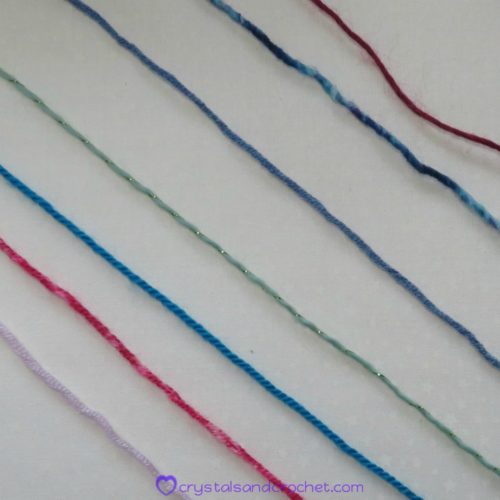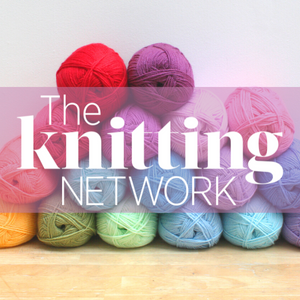Many of you have asked about choosing yarn and how to swap weights, the best hook size for the different weights and numerous other questions about yarn.
So, I thought I would write a little post about yarn….
Ummmm…. Well it was going to be a little post BUT… I would grab a drink and some nibbles because you may be here a while!
Let’s start at the beginning and look at what yarn actually is.
The yarns we use today can be made from almost any fibre, both natural and synthetic.
I am not going to get into the environmental debate, but any yarn that is produced has some form of impact on our environment. The main thing to think about is the durability of the yarn, this is not something like a plastic bottle that will be used once and thrown away. Most items you make will last for years.
The processes used to make yarn, from shearing sheep for their wool, to producing nylons and acrylics all have an effect or impact on our planet, if this is something that concerns you, then please research the manufacturing process for your chosen fibres and make an educated choice.
Historically yarns were spun, by hand or machine, producing one single thread. These threads were then twisted together to form the working yarn. If 2 threads were twisted this was 2-ply, if 10 threads were twisted together this was 10-ply.
But the spinning, twisting and production of modern yarns is very different today, and there are new types of yarn coming on to the market all the time. Again, if you want to learn more, I encourage you to do some research, but be warned it is a bit of a rabbit hole!
This is just a small selection of yarns, but you can see some are hardly spun at all and others are very tightly spun and twisted, at the bottom you can see the new Stylecraft Moonbeam yarn, this is almost like a stockinette.
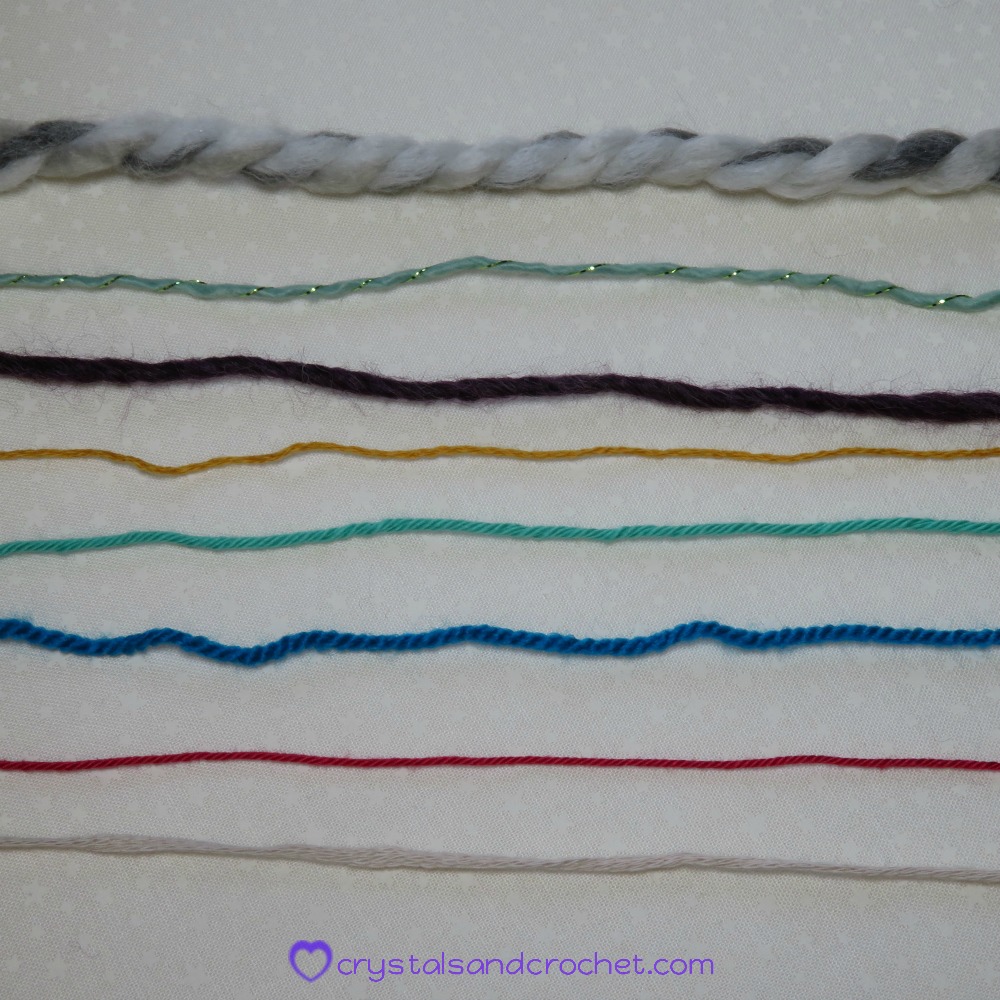

Ok, are you sitting comfortably?
What is yarn weight?
Yarn weight is how thick or thin the yarn is, not the weight of the ball or skein it comes in.
Years ago, there was the ply standard, or in the USA the weight standard, but the internet means the world has become smaller and we all buy yarns from all over the world, this has led to a blurring of the standards and a lot of confusion.
What are the different yarn weights?
To me a picture paints a thousand words.
These are the most common weights of yarn with symbols, names and ply.
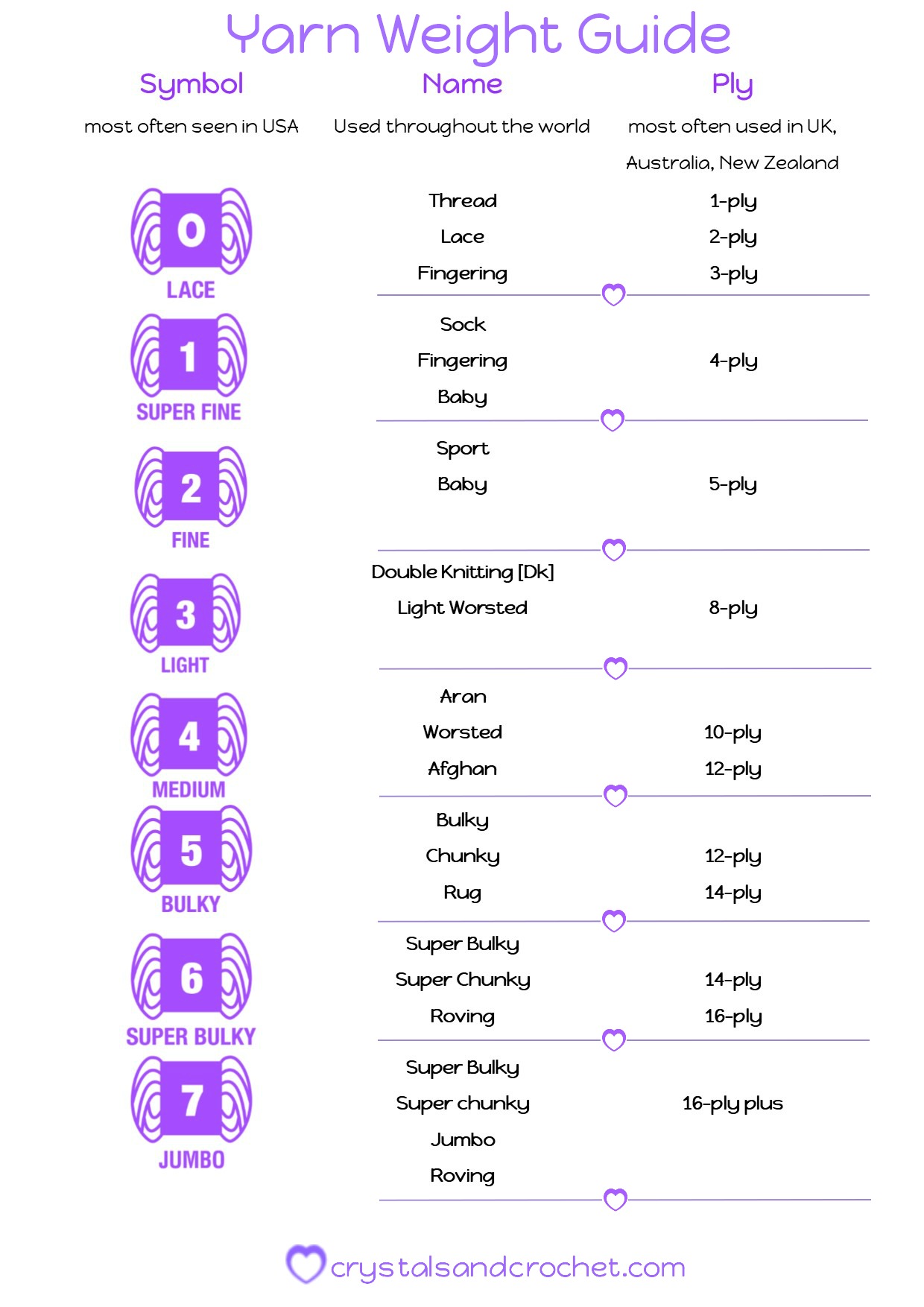
Can I mix different weights of yarn?
If you are working in freeform then yes mix away to your hearts content.
If you are following a pattern then NO, use just one weight of yarn or you will have all kinds of problems and your finished item will be uneven.
Can I mix different brands of yarn?
Absolutely YES. But always stick to the same weight.
There is no brand of yarn that has all the colours you will ever want, so mixing brands can work really well.
I used to mix King Cole, Hayfield, Sirdar, Scheepjes, Deramores Studio, and Stylecraft. All Dk weight yarns, also all acrylic, but do be aware that some will feel denser than others, although they are all the same weight.
Why do yarns listed as the same weight have such different thicknesses?
The simple answer to this question is the manufacturing process or the fibre content.
For example; a cotton will feel thicker or heavier than an acrylic or wool, and wool often feels the lightest or thinnest.
The spinning process also plays a role in the way a yarn looks or feels, the more highly twisted the yarn is the denser it will feel, and it may look thinner.
This photo shows many weights of yarn, but also different fibre content and twist processes.
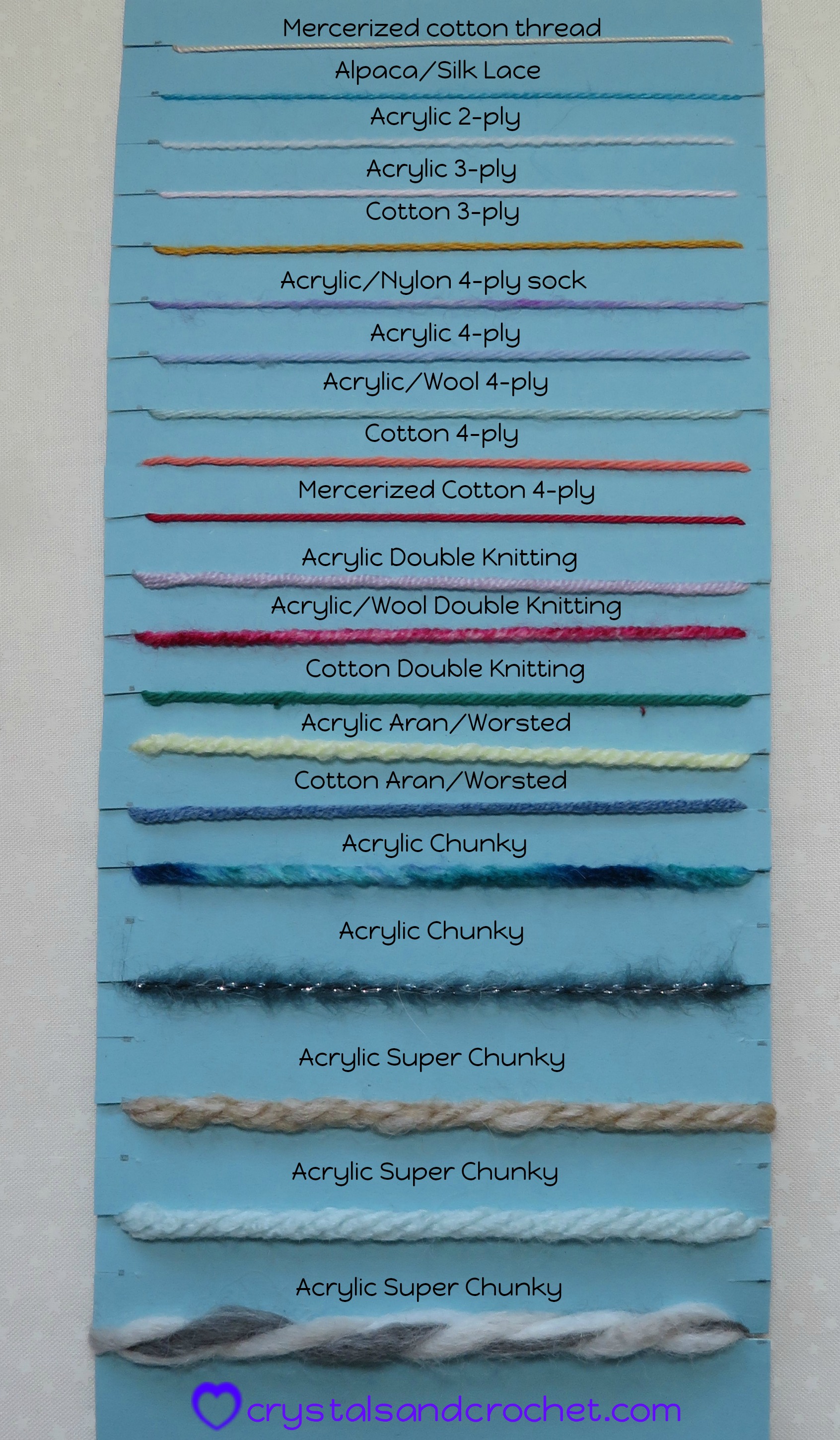
Can I mix different fibre content yarns?
Yes, you can.
Many modern yarns are already a mix of fibres, wool/acrylic and cotton/acrylic yarns are very popular, but you can also mix acrylic with wool or cotton yarns. The one thing I would point out is the aftercare needs, high wool content yarns will need cooler temperatures to wash and will not like being put in a dryer as heat will felt the fibres of the yarn. As a general rule always follow the after care for the most delicate of the yarns you use.
Which is the best yarn to use?
Understanding the differences/benefits to using cotton, acrylic, or blended yarn.
Always think about what you are making, what will it be used for?
Cotton is perfect for household items, wash cloths, mats, rugs, cushions, children’s toys, cool summer garments, it’s absorption rate is wonderful, but this does mean it can feel heavy and take a long time to dry, also with cotton you will need to reshape it each time you wash it. Cotton, and especially mercerised cotton gives great stitch definition as you will see in some of the photos later on.
Mercerised cotton is perfect for making bags and doilies because it will never pill and maintains a beautiful smooth sheen.

Cotton has little to no stretch and so will maintain its shape but is often the hardest fibre content to work with, especially if you have problems with your wrists or hands.
Some cotton yarns will not be dye fast and so the colours can run when you wash them, take care when mixing very bright or dark colours with pale colours.
Although one cotton I have found NEVER has colour run problems is Stylecraft cotton Classique, it is my go-to cotton yarn and I love the cushions I have made with it.
Always make sure you buy the same dye lots with cotton as colours can vary from lot to lot.
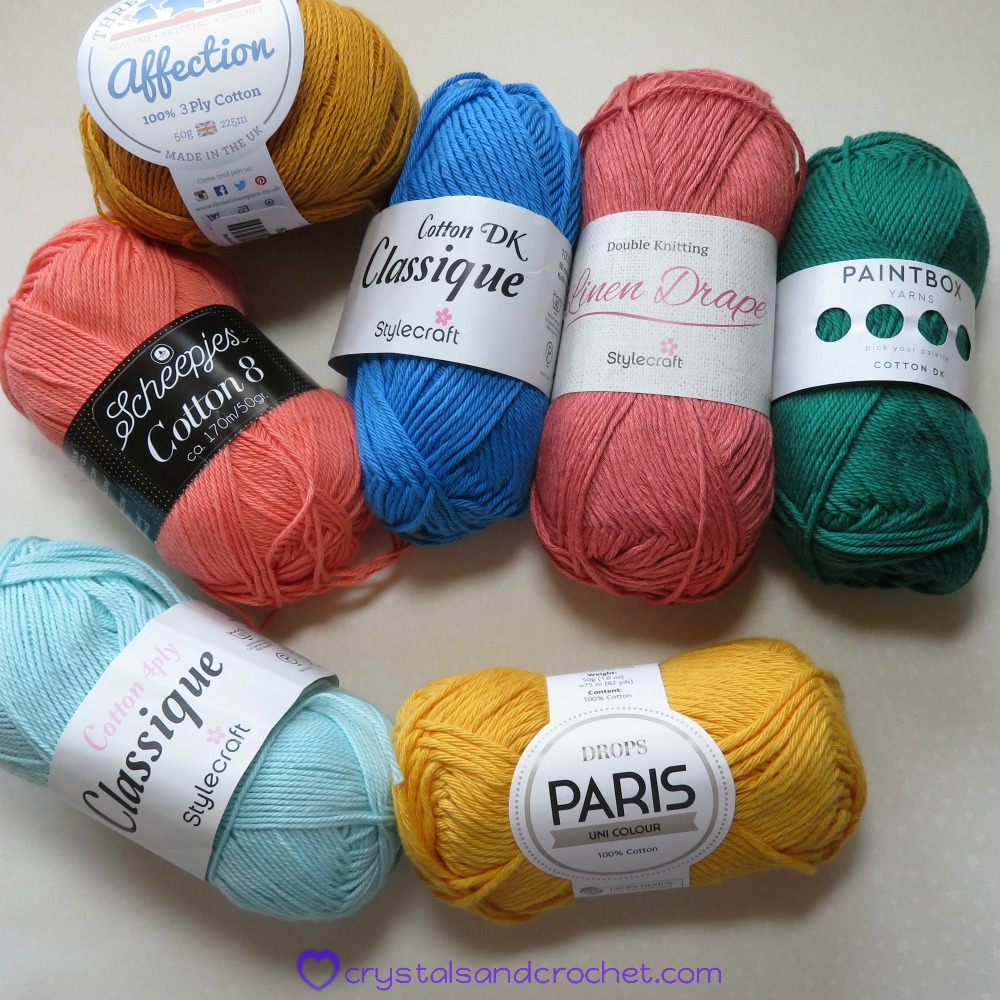
Wool is great for warmth, for blankets, afghans, garments.
Many people, myself included, have problems with allergies to wool, this is something to be conscious of if you are making gifts for people. I find I can work with up to 25% wool content, but that will still make my skin itch like crazy and I get little blisters on my hands when working with it, although I love the look of wool, it just doesn’t like me much.
Some wool based yarns will not be dye fast and so the colours can run when you wash them, take care when mixing very bright or dark colours with pale colours.
I was devastated when I made my Mandala Madness with Merino Soft yarn and washed it, the deep red and purple ran and the pale yellow and pale pink looked grey and muddy, I quickly put it back in the wash with about 10 colour catcher sheets and all was saved, but it made me very cross at the time that there was no warning anywhere on the ball band or in any of the manufacturers instructions that warned of this happening [they have changed that now], but were very unhelpful at the time and more or less told me tough luck!
Always make sure you buy the same dye lots with wool as colours can vary from lot to lot.
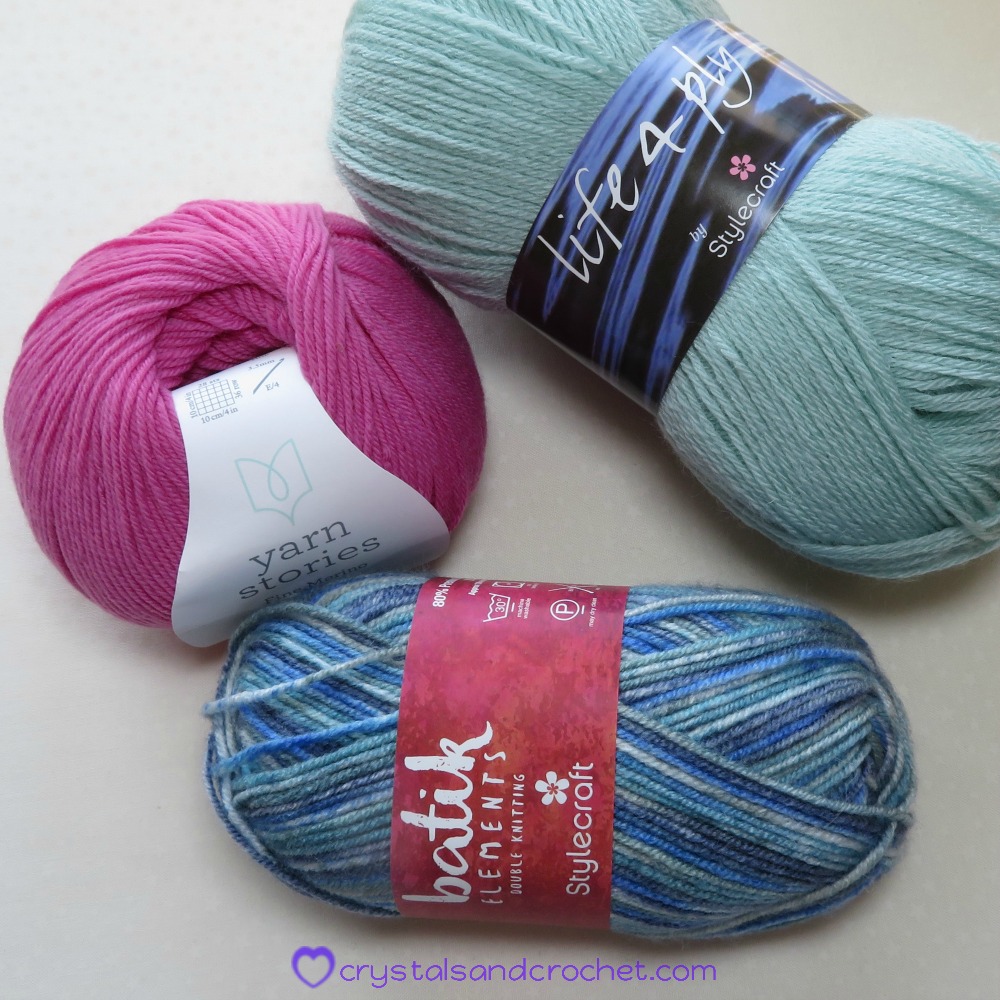
Acrylic is perfect for blankets, afghans, children’s toys, garments, anything that will be washed over and over.
Acrylic is my absolute favourite yarn to work with, I find it is always consistent, and so easy to work with. In fact, with my Clover Amour hooks working with Stylecraft Special Dk or Aran is effortless.
There are some cheaper acrylics on the market that smell quite strongly of the processing and dying, and they can have a plastic feel to them, but the premium acrylics are soft, and the colours are consistent with rarely any difference between dye lots.

Acrylic/cotton mix yarns are also great for cushions, toys, bags, and will be a little more robust than acrylic alone, or cooler for use in warm countries as blankets and throws.
Wool and acrylic can be smooth or fluffy, the smoother the yarn the greater stitch definition you will achieve.

What if I want to use something other than the recommended yarn?
Most designers, like me, will work with a yarn they like, you may like a different brand, and there is nothing wrong with swapping brands.
If you want to swap the fibre content, then do think about the use and the information I have given above, a designer will choose a yarn suitable for the item they are designing.

How do I know if I will like a yarn I order online if I cannot squish it?
We all love to have a good squish, right?
It is part of the addiction we all have, it is about the feel of what we are using and the feel of the finished item.
When ordering online it is very costly to order just one ball of yarn, but maybe the best thing is to ask others what they think. I often see this in the crochet groups on Facebook. But if the worst comes to the worst you can add the odd ball or two to an order of something you know you like, this is what I have done in the past, and if I did not like the yarn, I only paid for 1 ball rather than 20!

How do I adjust the amount of yarn I will need if I use a different weight to the one the pattern recommends?
Only change the weight of yarn if it is an item like a blanket, if it is a garment it will likely end up way too big or small!
But I spent the day making up squares to see what differences there are, this is only for 4-ply, Double knitting [Dk] and Aran/worsted.
I used the recommended size hook for each of the yarn weights.
I made a 2 round Granny square, and then undid it to accurately measure the amount of yarn used.
Normally if I am measuring yarn per round in a pattern, I weigh the yarn and round up to the nearest gram, but I wanted this to be spot on!
4-ply – 3.5mm hook – yarn used 350cm/138 inches – size – 4 cm/1 ½ inches.
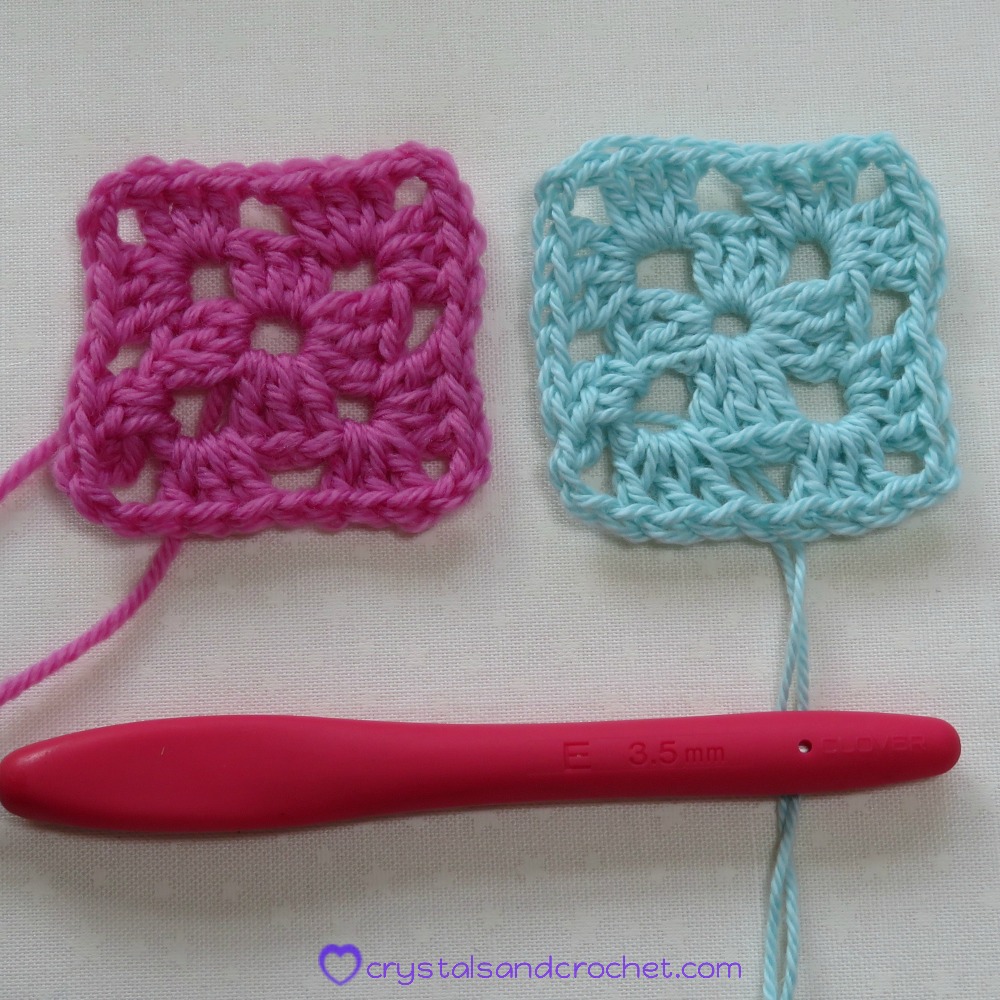
Here is something interesting…. only with the Dk yarn did I have a difference in length of yarn used for the cotton, I used slightly more yarn, but the squares were the same size.
Dk – 4mm hook – acrylic/wool yarn used 415 cm/163 inches – size – 4.5 cm/1 ¾ inches.
cotton yarn used 455 cm/180 inches – size – 4.5 cm/1 ¾ inches.
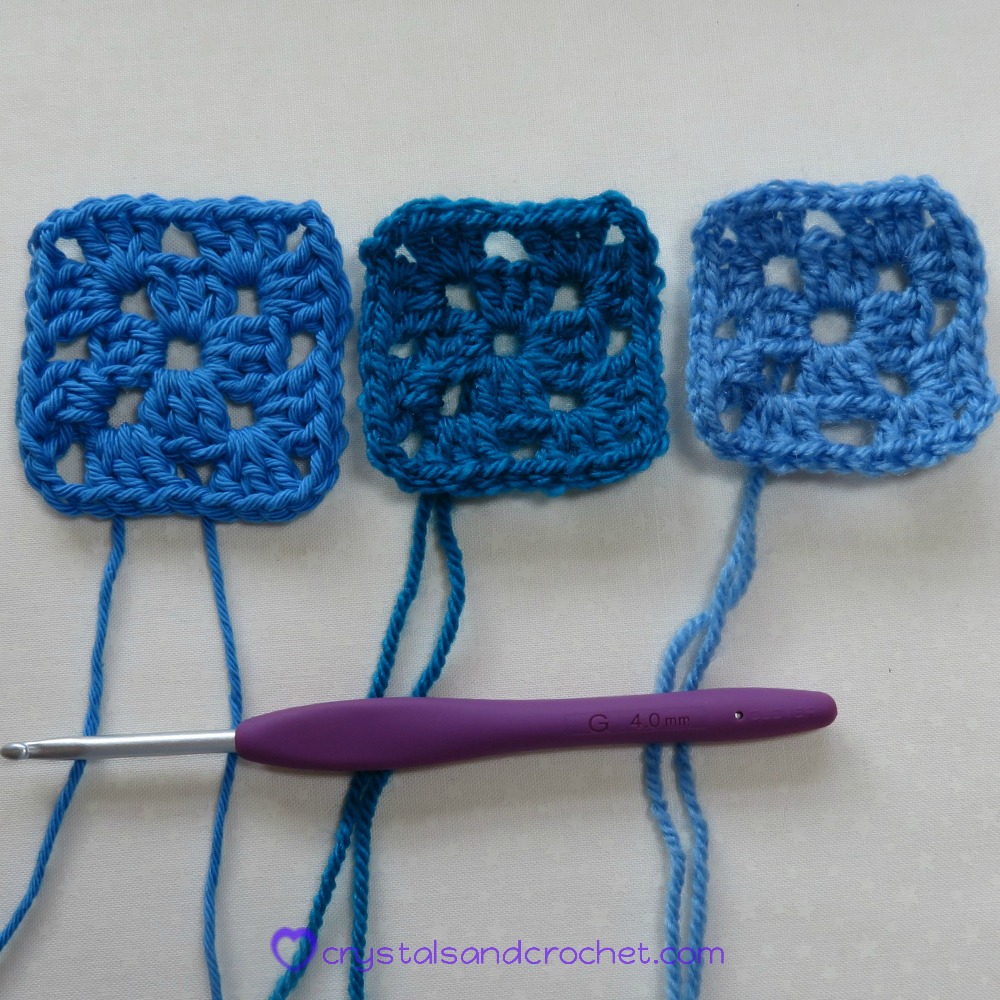
Aran/Worsted – 5mm hook – yarn used 530cm/209 inches – size – 6 cm/2 ¼ inches.

The maths bit…. working on the shorter amount of yarn used there is an increase of 18 to 18.5% as you increase yarn weight and hook size.
With the longer amount of yarn used [the cotton] there is an increase of 28 to 30%.
I have often told people to work on 20 to 25% more yarn as they increase weight, and I think I am going to stick with that guestimate!
But…. do remember if you crochet tightly or more loosely then the amount of yarn you use will vary.
Maybe this is a good time to remind you of a post I did before we started the Cosmic cal last year….
Talking tension, there is a blog post and, also a video. So do watch/read which ever works best for you.
Also remember that the finer the yarn and smaller your hook the smaller the finished item will be, and the same with thicker yarn and larger hook size, your finished item will be larger.
As you can see above my 4-ply square is 4 cm/1 ½ inches.
The square made with Dk is 4.5 cm/1 ¾ inches a 12.5% increase in size from 4-ply.
The square made with Aran/Worsted is 6 cm/2 ¼ inches a 25% increase in size from Dk.
So if you are making a blanket and it has been designed and made in Dk with a 4mm hook and the finished size is 152.5 cm/ 60 inches and you want to use an Aran/worsted weight yarn with a 5 mm hook or larger you will end up with a blanket approx. 190.5 cm/75 inches in size.
Another very common size thing…afghan squares, many of the squares you see on Ravelry are 12 inch squares, this is with Aran/Worsted yarn and a 5 mm hook, these will come out at 10 inches with Dk yarn and a 4 mm hook.

Let’s chat about hooks for a moment….
A comment that was made recently in the Stylecraft Blogstars group was why is it all yarn producers favour knitters when it comes to needle/hook size and tension?
Well the wonderful team at Stylecraft are listening and are working towards a standard across their yarns.
Although not all yarns are suitable for crochet work, but that we will cover later.
Knitting needle and crochet hook sizes are the same in millimetres, so that makes life a little easier for us hookers.
It does not matter what brand of hook you use, but the hook should glide effortlessly through your yarn, it should not snag or split the yarn. Your hook should be comfortable for you to hold, pencil hold folk like me like a slim hook, knife hold folks can use a hook with a slim or chunky handle.
No rules, just what works for you.
I have to say I just love my Clover Amour hooks, they are comfortable, smooth, and pretty colours, because I am a girl after all and colour matters!
Choosing hook size
What hook size do I use for the different types and weights of yarn
Time for lots of photos….
Crochet Thread or Yarn is the same thing and you can use anything from a 1 mm to 2 mm hook, that is a UK 14 or smaller and a US 0 or smaller.

Lace weight yarn is very similar to thread, here you can see I have made the same motif but with very different hook sizes, lace yarn is meant to be very lacy so a larger hook, size 3.5 mm is recommended.
Lace yarns are often fluffy with angora or mohair mixed in and the larger hook gives a wispy effect to the stitches.

For 2-ply yarn use a 2 mm to 2.5 mm hook, US 0-B/1-C/2, UK 14/13/12.
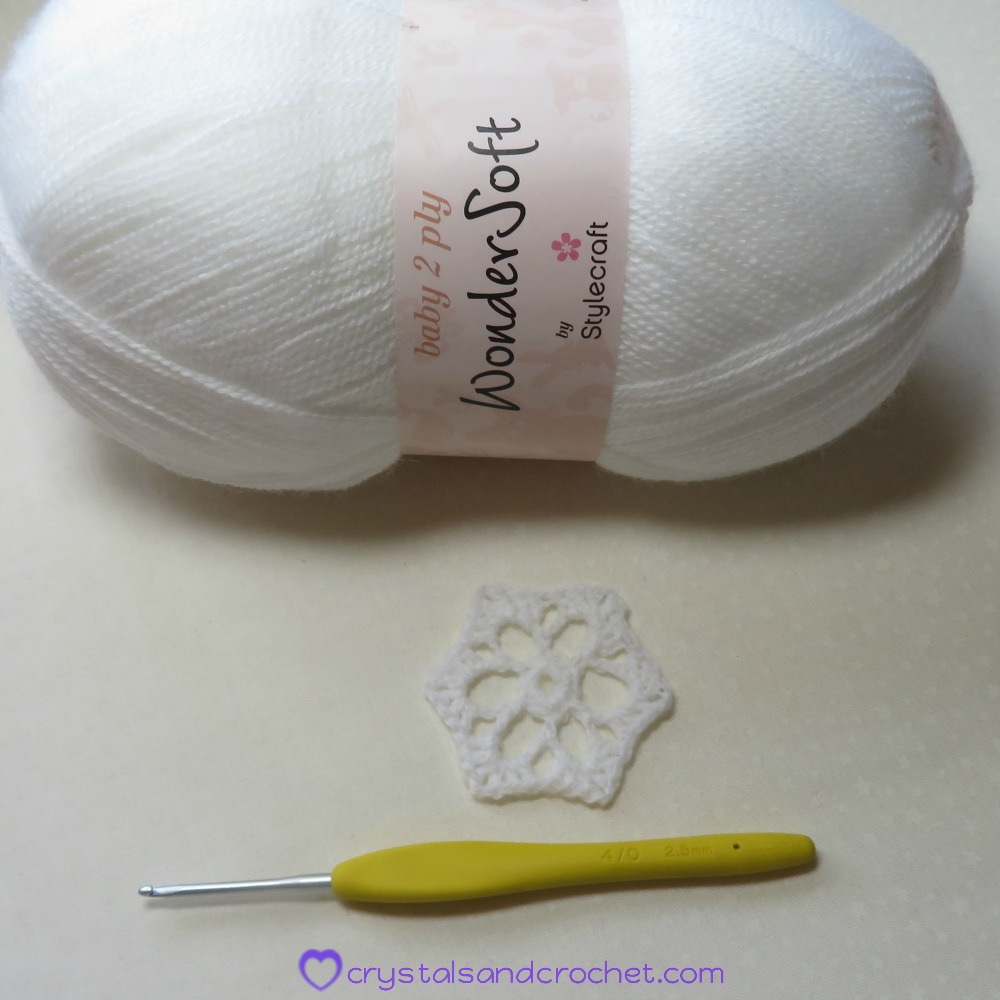
For 3-ply yarn use a 2 mm to 2.5 mm hook, US 0-B/1-C/2, UK 14/13/12.
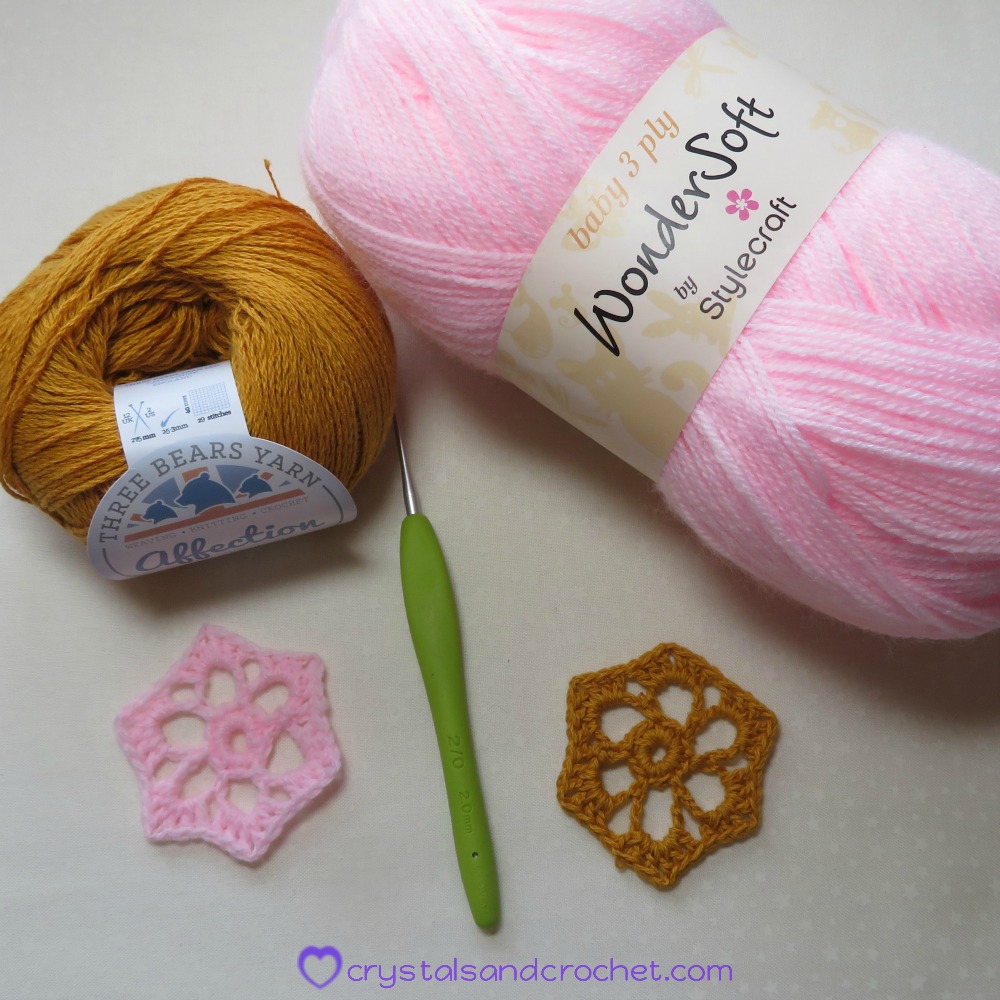
With 4-ply yarn use a 2.5 mm to 3 mm hook, US C/2, UK 12/11.

Double Knitting yarn use a 4 mm hook, US G/6, UK 8.

Aran/worsted weight yarn use a 5 mm to 5.5 mm hook, US H/8, I/9, UK 6/5.

Chunky yarns use a 6 mm hook, US J/10, UK 4.

Super Chunky yarns work best with hook sizes 10 mm and larger, US N/15 and larger or UK 000 and larger.

Why is the size of the hook sometimes changed mid-pattern?
If you are making a garment and the edging needs to be tighter than the main body of the item, then changing hook size makes sense.
However, if you are making a blanket there should not be the need to change hook size, as you want it all the same tension.
Another however, if a design has lots of single crochet in it then it is easy for your tension to become tighter and the taller, looser stitches around it will seem baggy, the same if a lot of chains are used, just remember that the top loops of all of your stitches and chains should be the same size.

Does colour matter?
Of course it does, like… do bears poop in the woods?
Colour is about feeling and emotions, colour has an energy vibration, some colours we like, some we don’t.
Colour influences our mood and our actions and reactions, it really is all about feelings.
I love all colours, like people they all have a place in the world and are beautiful in their own way. However, there are some colours I tend to like around me and others I am not so keen on, I love pinks and blues and purples and all the cool bright colours. But I understand that many of you will be drawn to warm colours or muted colours, that is why I try to change up the colours I work with for the yarn packs I make up.
One thing I can not do is work in all one colour, to me it is the same as working a whole blanket in the same stitch….boring!
BUT some of you love to work in all one colour and that is wonderful, and some of the one colour Mandala Madness or Cosmic cal’s I have seen are simply stunning.
I have a whole section on my website dedicated to posts about colour, so if you struggle take a little look around and see what you can learn.
Swapping brands to find the colour you want? Yes go for it, I already mentioned that above, and as long as you keep to the same weight of yarn then you will be fine and have exactly the colours you want.

Here is an interesting question
What type of pattern/row is variegated yarn most suited for and when is it possibly least suited in a pattern?
Variegated and short colour change yarns are designed for knitting which has a very flat surface, the multiple colours create interest in the work, so variegated yarns work well for plain stitches.
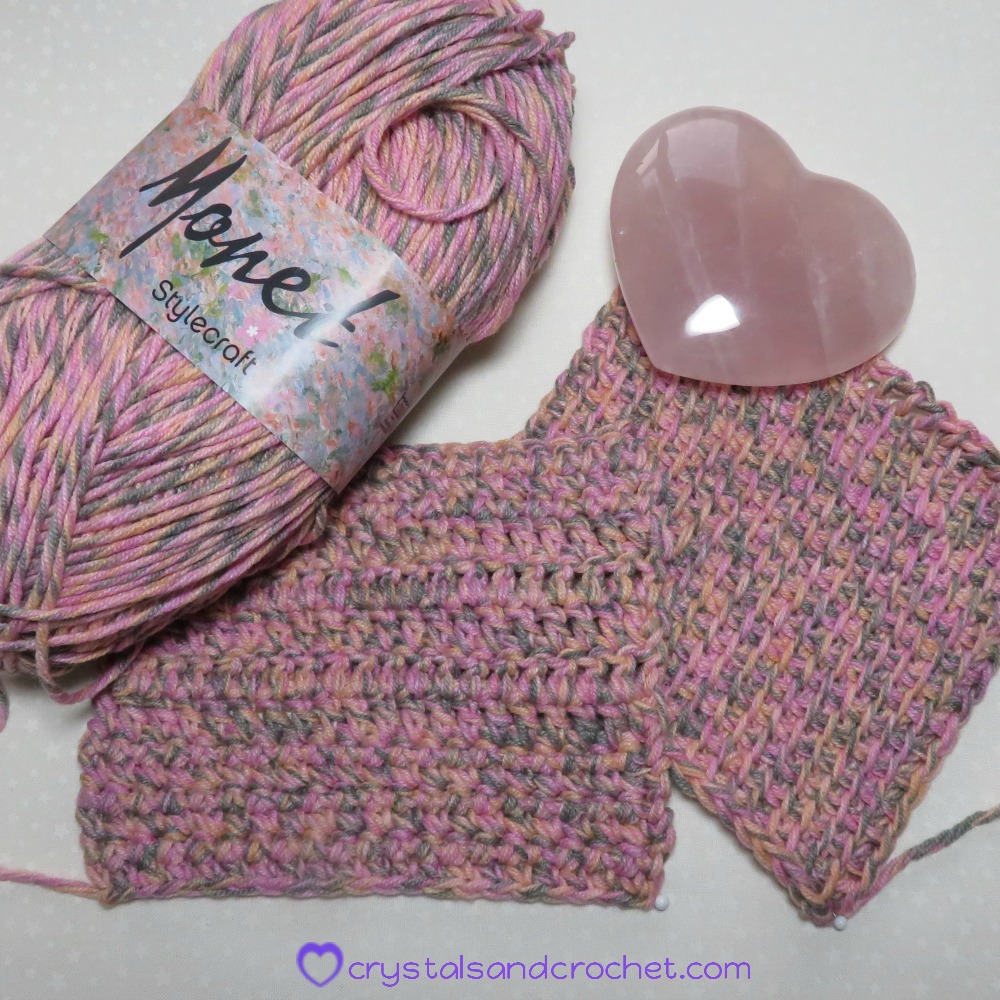
When a piece of work has a lot of textured stitches the sudden or rapid changes in colour fight with the texture of the stitches and the impact of the stitch and the colour become lost.
You can see in the photos above for the hook sizes, with the multi coloured yarns you loose stitch definition, with the solid coloured yarns the stitch definition is far better.
Here is another photo to show you the effect colour has on the same motif, with the solid colours we can see the stitches clearly, with the two motifs made with non-solid colours we loose definition of the stitches.

I used a variegated yarn in one of the Cosmic cal yarn packs, used on large plain sections and mixed with solid colours for the “special” stitches it works beautifully.

There are many long colour change yarns on the market now, these were brought about from the need to not change colour, but to achieve an ombre effect where one colour gently fades into another.
The first of these I came across was the Wolltraum yarns, My Melodyy, they are made from very thin strands of yarn, with no twist, all strands start off the same colour and then 1 is changed, then a 2nd added etc until you have a solid colour again and this method is repeated to give the very gradual change.

When the mass producers caught on to the success of this awesome yarn they used “normal” acrylic or fibre blend yarns and the colour changes are very abrupt, again this can work, or it can look very odd when the colour changes mid stitch or mid row/round.

It is all about personal taste, I love the very gradual colour change, but not so keen on the sudden change ones.

Finally lets mention yarn quality.
As with everything in life you get what you pay for.
But there is no need to be a yarn snob, everything has it’s place, and a good quality yarn will wash and wear well, and last for years.
It is really all about personal choice and what you can afford.
You can produce stunning work with low cost yarn, but sloppy work is sloppy no matter how much the yarn cost.
Personally, I can’t wear or use wool so I would find it a complete waste of time and money, but if you don’t like the feel of acrylic then don’t use it.
There are many very good quality yarns available today at a very reasonable price, so go with what suits you and your wallet.
I hope you have found my ramblings about yarn helpful, we all learn as we go along, and if you want to know more about any of the points that are raised here, google is your friend. ♥
♥ If you need help and advice, the quickest way to find support is to join Helen’s Hookaholics Facebook group. There you will find a very supportive group of likeminded people. It’s also a great place to share your crystalsandcrochet makes, and see what others are making, and see what I am up to.
♥ If you are not a fan of Facebook you can always email me with any questions you may have by using the contact form here.


